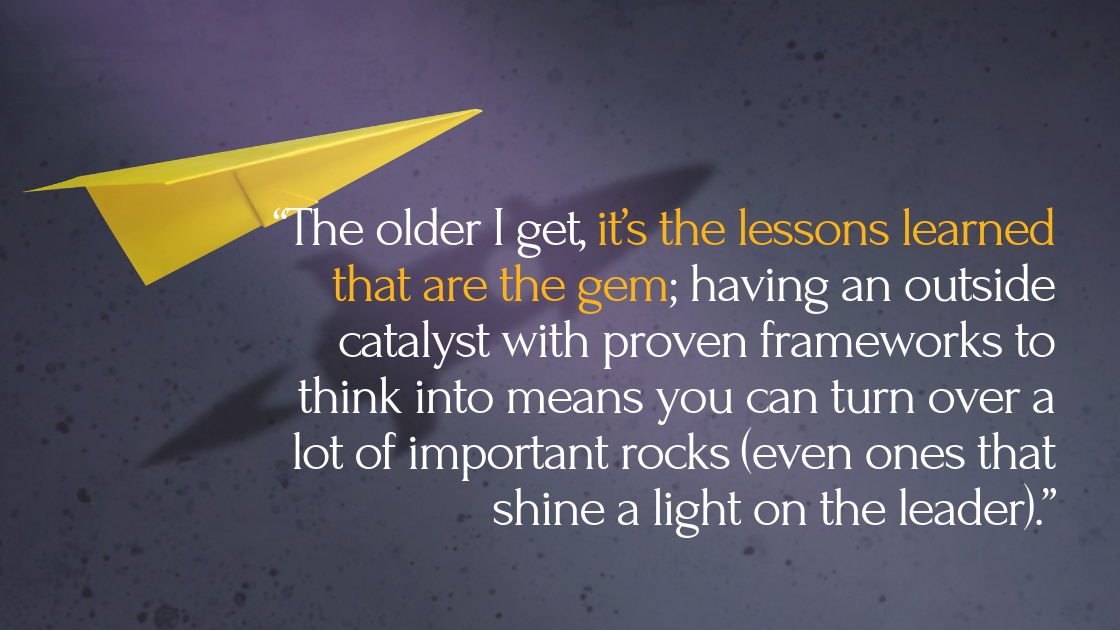What To Do Between Your Exit and Next Position
We wrote a post about how to make a graceful exit (especially when it’s involuntary) that explored what steps to take when leaving your position. This post is the follow-up that dives into how to identify, assess, and consolidate lessons learned to find the right next job. We’ll explore three key steps to a successful transition plan for CEOs.
When most executives leave a job (voluntarily or otherwise) they fire on all cylinders to get the next one right away. It’s human nature. After years, and often decades, rushing to work every morning it just feels wrong to do otherwise. Besides, no one wants to have to explain a gap on our resume.
Perhaps surprisingly, the better plan is the exact opposite of what comes naturally. Instead of jumping right into the next gig, exited leaders should take stock, take a break, and ramp up using some softer skills. This process will help to avoid making the same mistakes again, make the transition experience a positive one, and to position for optimum performance in the next role.
What To Do After Exiting
Take time to reflect on the past experience in order to learn from it all you can, take a break to get energized, and then ramp up into the right, next position for you. While it may sound obvious, simple, and straight-forward, too many talented CEOs skip one or more of the three steps or do them in the wrong order.
Doing so runs the risk of making the same mistakes again, burnout, and/or missing out on the right next position.

1. Take Time to Reflect
This is the most commonly skipped step and yet it is by far the most important. If you’re leaving a position, regardless of the reason, to pursue another — there’s surely something to be learned and gained from your last one.
Take the time to dig-in to crystalize in no uncertain terms:
- What you were trying to do
- What you did to do it
- What happened
- What you learned, what could you have done differently to get a better result
- What you will do differently next time to uncover valuable insights about yourself and what’s right for you next.
The way we say it is: “If you haven’t been brought to tears with self-realization, you need to go deeper”.
For more probing questions to drive penetrating self-analysis, download our Executive Self-Reflection Exercise.
Executive Self-Reflection Exercise

2. Take a Break
Executives who skip the first step almost always skip this step as well. They are already tenaciously pursuing the next job before they’ve had a moment to let anything sink in.
Don’t skip this step.
Take a break. A short one is okay assuming it is meaningfully long, whatever meaningful means to you. The idea is to take time to process what you uncovered during the self-analysis in the first step. Then, take a breather to re-energize by doing something you love whether it is relaxing on a beach, climbing a mountain, visiting a new city, or whatever works for you.
Self-analysis without the time to internalize, consolidate, and otherwise process is worthless, because the insights slip from memory before they have time to harden. Without recognition of changes you’d like to make and thoughtful application of those changes, nothing will change.
You’ll go into the next job making all the same mistakes and get the same results.

3. Prepare For Your Next Position
With self-awareness in hand and identification of what you’d like to change in the works, you can begin to prepare yourself for your next role. As you can, this is another reason it’s helpful to have some downtime between roles.
You need time to decompress before you ramp up again to full throttle. When you are ready, take what you’ve learned and gained from steps 1 and 2, then follow the professional process in my post on How to Find a Job.
Finding the right next job is itself a job, and it can be simple but that doesn’t mean it’s easy! Dedicate your full time and attention to following this professional process which works every time for those with drive and determination. It works especially well for those who develop and apply a new, enlightened mindset to the effort.
Watch this short video clip to learn how to manage a portfolio of pursuits over time to lead a full and rewarding life. And this clip explains why it’s okay to be who you really are!
Get Help From a Pro
A client of mine recently shared this thought in an email when recommending IntelliVen to an executive seeking coaching:

While you can take these steps on your own, having an outside catalyst will ensure that you do so efficiently and thoroughly. A good coach will put you through the paces — it will be uncomfortable, difficult, and absolutely worth doing.
Often our self-analysis is at first singular and shallow. It’s difficult to move past what feels known beyond the superficial to get to the core of an experience. A coach works as a guide to push you when the answer you think is “it” is really just going through the motions.
Executive coaching saves time and improves results. It will also push your personal and professional learning and development into high gear to help you find the right next position… not just another version of the ones you’ve already had.


Also consider engaging a counselor, therapist, etc to help understand more about steps you can take to learn and improve.